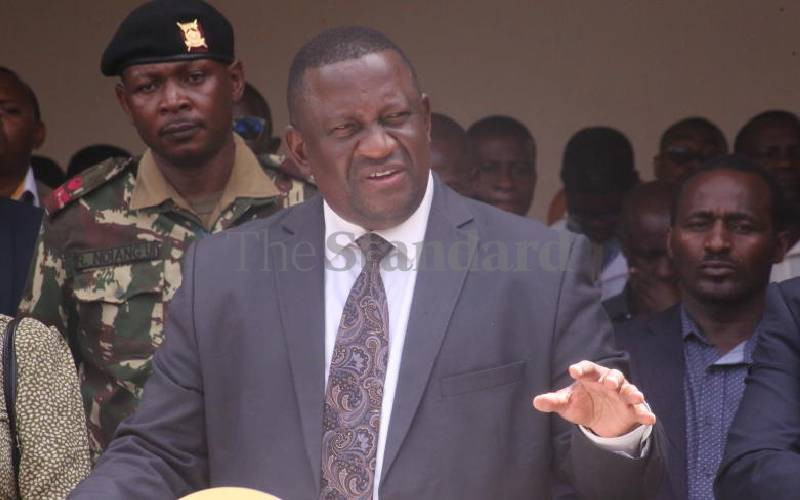The economic crisis brewing in Kenya is forcing many to implore the government to implement bolder and more courageous measures to secure the country from the largest economic disruption since the Second World War.
Economists have been reflecting on the words of the former chairman of the Federal Reserve, Ben Bernanke, in his book, The Courage to Act: A Memoir of a Crisis and Its Aftermath.
He recounts the efforts by his team to save the world from a depression, saying “If we acted, nobody would thank us. But if we did not act, who would? Making politically unpopular decisions for the long-run benefit of the country is the reason the Fed exists as a politically independent central bank.”
Last week Moody’s credit rating agency raised a red flag over Kenya’s borrowing habits, coincidentally at the same time when the National Treasury was preparing to receive a loan package of Sh122.5 billion from the IMF and World Bank.
Furthermore, the fund has called for Kenya to reverse the tax cuts that were recently announced by the government to cushion Kenyans from the effect of Covid-19. There is a growing consensus among economists that there is very little headroom for additional borrowing. Putting it simply, we have exhausted all the tools of fiscal policy. Could this be the time we must make the bold move towards monetary policy to save the economy?
Monetary policy is almost entirely within the province of the Central Bank of Kenya and is mainly involved with ensuring adequate liquidity within the economy. This has certainly not been achieved over the last few years, which have been characterised by a severe cash crunch that started in 2016 with the interest rate cap and was exacerbated by the demonetisation exercise last year which saw cash in circulation drop to a six-year low.
The first step in fixing Kenya’s monetary policy is to appreciate the two most important economic trade-offs in any country: Inflation and unemployment, which come together to form the Philip’s curve. Nobel prize economist George Akerlof once referred to it as the most important macroeconomic relationship.
While inflation has been tracked very well in Kenya, unemployment statistics have not always been readily available, hence making it almost impossible to model a Philips curve for Kenya which can guide policymakers on the optimal levels of money supply needed to stimulate the economy.
Interest rate
The second step towards better monetary policy is in finding a benchmark interest rate that truly works. The most important property of a good benchmark interest rate is in its ability to effectively increase or decrease liquidity into the economy, following an increase or decrease in the benchmark rate. The current Central Bank Rate has proved to have a weak transmission signal to the real economy.
Efforts to reduce it have had little impact in terms of releasing liquidity, partly because commercial banks rarely factor it in their cost of funds. If anything, banks prefer to borrow amongst themselves in the interbank market, which means the overnight rate is a far better benchmark rate. Indeed, this is the benchmark used in the US, in which the Federal Funds Rate is anchored on the overnight rate and which has proved to be a far more effective rate.
Moreover, it would also go a long way in providing forward guidance if the minutes of the monetary policy committee would be made public to allow market players to have insights into some of the considerations made by the Monetary Policy Committee when setting interest rates.
Finally, and most importantly, some work should go into developing a framework on CBK’s responses during times of economic crisis. This should explore how, during times of severe economic distress, the CBK can create and inject liquidity directly into the economy to sustain jobs.
Kenya also has the added benefit of high mobile money penetration, which makes it possibly the only country in the world whereby a central bank’s monetary stimulus can directly target the ordinary citizen, bypassing the bureaucratic red-tape that tends to suffocate traditional stimulus programmes. Indeed, the role of fintech in boosting the money supply in a country will most certainly emerge as one of the hottest areas of economic research in post-Covid Kenya.
By achieving these measures, Kenya will emerge as a shining beacon of sound monetary policy, leading other African nations away from the historical path of devastating debt.
Stay informed. Subscribe to our newsletter
-The writer is Chief Economist at Mentoria Economics.
 The Standard Group Plc is a
multi-media organization with investments in media platforms spanning newspaper
print operations, television, radio broadcasting, digital and online services. The
Standard Group is recognized as a leading multi-media house in Kenya with a key
influence in matters of national and international interest.
The Standard Group Plc is a
multi-media organization with investments in media platforms spanning newspaper
print operations, television, radio broadcasting, digital and online services. The
Standard Group is recognized as a leading multi-media house in Kenya with a key
influence in matters of national and international interest.
 The Standard Group Plc is a
multi-media organization with investments in media platforms spanning newspaper
print operations, television, radio broadcasting, digital and online services. The
Standard Group is recognized as a leading multi-media house in Kenya with a key
influence in matters of national and international interest.
The Standard Group Plc is a
multi-media organization with investments in media platforms spanning newspaper
print operations, television, radio broadcasting, digital and online services. The
Standard Group is recognized as a leading multi-media house in Kenya with a key
influence in matters of national and international interest.









